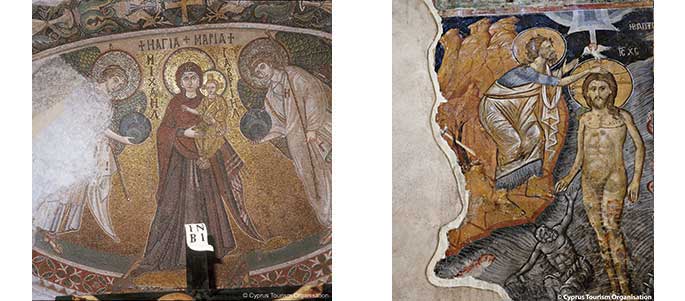
Monasteries
Since the Early Christian Period many monks came to live on the island to apply their ascetic practices. They travelled from places like Syria, Egypt, Minor Asia where conflict against Christians made their lives dangerous and impossible. Around the island there is a great number of places of ascetic practice and of worship, numerous tombs, crypts and sarcophagus, that confirm this tradition. Following the war on icons, monasticism is transformed into a more organised form in Cyprus and is closely related to the central power of the Byzantium. The strong connection to Constantinople is obvious in the structure, architecture, art and style of some of the most imporant monasteries in Cyprus like the Monastery of St John Chrisostom, Our Lady of Kykkos, Our Lady Phorviotissa and others.
List of some of the most important Monasteries:
Christianity
The Imperial recognition of Christianity in 313 by Constantine the Great and Licinius transformed the Roman Empire. Christianity became a state religion and played a leading role in the history of mankind. Constantine became the Emperor of the Roman Empire in 324 and in 330 he transferred the capital from Rome to Constantinople. The Greek city state of Byzantium became the greatest creative centre of medieval times. In the division of the Roman Empire into East and West in 395, Cyprus was included in the Eastern division. By the end of the 4th century AD, the Church of Cyprus was fully established and highly organized with bishops in all the main towns.
The Church of Cyprus was an apostolic foundation that was established by the Apostles Paul and Barnabas. Emperor Zeno (474-91) declared the Church of Cyprus Autocephalum (Independence) and conferred on the Archbishop of Cyprus three royal privileges: the right to carry an Imperial sceptre, to sign in red ink, and to wear purple instead of black robes under his vestments.
Byzantine Art
Byzantine art is almost entirely concerned with religious expression. There are different forms of Byzanine art like architecture and painting. The style in which mosaics and frescoes were created reflected their function as static, symbolic images of the divine and the Absolute. The mature Byzantine style, evolved through the stylization and standardization of late classical forms of Early Christian art, was based on the dynamic of lines and flat areas of color rather than form. The Byzantine image is more remote and more immediate than the naturalistc classical one. Huge eyes, penetrating gaze, the characteristic use of a gold backround.
Byzantine art was born after the recognition of Christianity as a State religion of the Roman Empire by Constantine the Great and the transfer of the capital to Constantinople in 330, in the middle of the Greek world and the crossroads of trading, military and artistic routes.
UNESCO Churches
The Convention concerning the Protection of the World Cultural and Natural Heritage was adopted by UNESCO in 1972. The Republic of Cyprus ratified the Convention in 1975 and became one of the nations committed to the protection of the world's cultural and natural sites. There is a large number of monuments and sites that reflect human activity and diverse past cultures on the island. The protection of this rich cultural heritage has been entrusted to the Antiquities Department of Cyprus.
UNESO Painted Churches of Cyprus
Saints of Cyprus
According to the Acts of the Apostles, St Paul and St Barnabas arrived in Cyprus on their first missionary journey in 45 A.D., when there was already an established Christian community on the island by those who had been dispersed by the persecution. St Paul succeeded in converting the Roman proconsul in Paphos to the Christian faith - making Cyprus the first country ever to be governed by a Christian leader. According to the biblical account, St Lazarus was resurrected from the dead by Christ and sailed from Bethany to Cyprus where he lived for another 30 years. Based on the local tradition he was appointed by Paul and Barnabas as the first Bishop of Kition. His sarcophagus is in the crypt of St Lazarus Church that was erected in the 10th century by Emperor Leo in Larnaka.
The Island of Saints: From apostolic times until modern times we know of 240 Saints from Cyprus. There are many who remain unknown and others who are only known to the people of Cyprus. Some of the most important Saints who were born and lived in Cyprus are St Heraklidios the first Bishop of Tamasos, St Neophytos the Recluse, St Theosevios of Arsinoe, St Irine the daughter of St Spyridon Bishop of Paphos. Other Saints who were born in Cyprus St Spyridon Bishop of Trimythous, St Demetrianos Bishop of Chytroi and St Polydoros the New Martyr of Cyprus and New Ephesus.
Other Saints of Cypriot origin who were born abroad are Apostle Barnabas the founder of the Cypriot Orthodox Church, Mark the Evangelist the nephew of Apostle Barnabas, St Lazarus of Bethany Bishop of Kition, St Epiphanius Bishop of Constantia and St Artemon of Avlona. Other important Saints who according to the local tradition visited the island for a short period are St Helen, Apostle Andrew and St. Nicholas Dvali.



